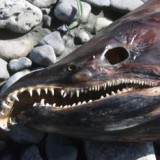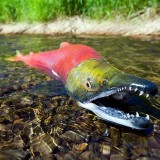The Norwegian salmon farming industry got a lesson in the old adage, “be careful what you wish for” this week when it learned of industry critic Don Staniford’s next job.
The British-born, globe-trotting salmon activist announced on his blog yesterday that following his scheduled deportation from Canada later this month he will be heading to Norway to work with that country’s leading environmentalist bad boy, Kurt Oddekalv, head of the Green Warriors of Norway.
The industry may have got its wish – seeing the last of Staniford in BC – but it’s turning out to be a case of out of the frying pan, into the fire.
Oddekalv had this to say on the development: “I am pleased to announce that Don Staniford is coming to Norway to spearhead the global work of the Green Warriors. Once he has finished fighting the Norwegian Government owned company Cermaq in the Supreme Court of British Columbia, Don is welcome here in Norway. Cermaq’s problems in Canada are coming home to roost.”
One of the industry’s three Norwegian titans – which together own 92% of BC’s salmon farms – Cermaq-Mainstream, is currently suing Staniford for defamation at the BC Supreme Court over his recent campaign comparing salmon aquaculture to Big Tobacco. On the opening day of the trial last month, officers from the Canadian Border Services Agency showed up to inform Staniford he would be deported following the trial for over-staying his visa. The charge is accurate, and yet it was hard not to draw a connection to the industry and its close ally, the Harper Government, given the place and manner in which Staniford was delivered the news.
Staniford and Oddekalv are unquestionably the global salmon aquaculture industry’s boldest foes. Both employ provocative tactics that consistently get under the industry’s skin. Their partnership is the salmon activist equivalent of Che Guevara and Fidel Castro joining forces.
I’ve met Oddekalv on several occasions and spent a few days at his Green Warriors headquarters near Bergen, Norway in 2009 – while working on my film “Farmed Salmon Exposed”. To describe Oddekalv as a character is an understatement. The man is a larger-than-life eco-Viking, always happy to regale his guests with tales of his daring exploits against the industry and other environmental violators in his native Norway.
Meanwhile, Staniford is the man who developed a global network of salmon farming critics through his former position as director of the Pure Salmon Campaign out of Washington, D.C. His quest against open net pen aquaculture has taken him to all the industry’s operations – in Norway, Chile, Scotland, Ireland, Canada and the US – many times over.
Staniford – who has also plied his trade in BC during an earlier stint with the Friends of Clayoquot Sound and before that in Scotland – decamped again to BC a year and a half ago, as the province was developing into the front line of the battle over salmon aquaculture. But in the course of that time, he’s gone from the director of a well-funded global campaign to guerrilla-style warrior with few resources, surviving mostly on donations from supporters (in recent weeks, his phenomenally successful legal defense fundraising campaign has netted some $50,000 in public donations).
Partnering with Oddekalv provides a major boost to Staniford’s work. Despite his comparably daring campaign tactics, Oddekalv runs a well-oiled operation – offering Staniford resources he has lacked in recent years. For Oddekalv – perhaps the only major environmental leader who would dream of hiring Staniford right now – the activist from Liverpool may prove a valuable catch. The two men’s tactical styles are a good fit – and Staniford brings to the Green Warriors of Norway a global perspective and rolodex to match, not to mention his unrelenting determination to take down the industry.
Staniford’s trial is due to conclude next week, after which he will be escorted out of the country at the end of February.
And from there, it will be very interesting to see what mischief these two salmon rebels make for the industry back home.







